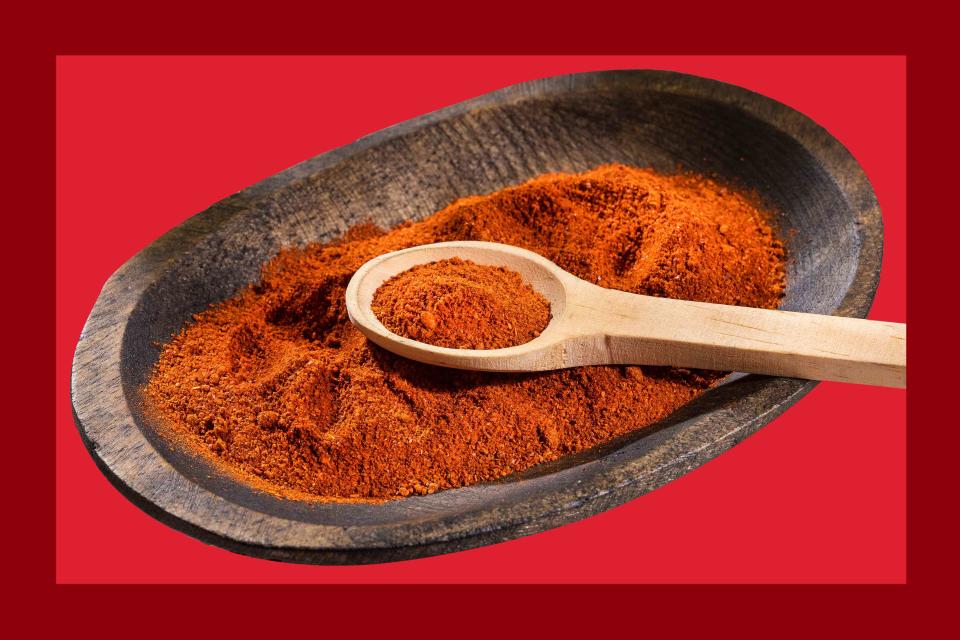How to Cook with Any Type of Paprika
Sweet, hot, or smoked, this pantry staple is worth getting to know better.

Getty
Made from a range of dried and ground peppers, paprika features in Hungarian, Spanish, Moroccan, and West African cuisines, among others, adding its vibrant red hue and mild red pepper flavor to dishes like Chicken Paprikash and the marinade for Piri Piri Chicken. While sometimes dismissed as one-note, high-quality paprika is beloved by chefs for its delicate sweetness and earthiness.
Here’s a guide to paprika, including the varieties to look for and how to use them.
What does paprika taste like?
Sweet paprika brings a mild bell pepper sweetness and earthiness to dishes. “The flavor is akin to raw fresh peppers and unripe tomato,” says Jeremy Salamon, chef and owner of Agi’s Counter in Brooklyn, which focuses on Hungarian, Austrian, and Jewish cuisine. Hot paprika has a spicier flavor that’s more similar to cayenne, while smoked or Spanish paprika is defined by its bold smokiness. Note that smoked paprika is also called pimentón, and is available in both hot and sweet varieties.
Is paprika spicy?
It depends on the kind of paprika you’re using. Sweet paprika generally has a very mild flavor, while hot paprika uses spicier chiles; smoked paprika can come in sweet or hot varieties. Which brings us to…
What is the difference between sweet and hot paprika?
Sweet paprika is made with milder chiles on the Scoville scale, usually ground red bell peppers. Mild and slightly fruity, it’s often used as a garnish for deviled eggs and is a classic ingredient in many Hungarian dishes, including Chicken Paprikash and Goulash. Most paprika on offer at the grocery store is sweet, unless indicated otherwise.
As its name implies, hot paprika is made with spicier peppers, often a combination of chile and bell peppers. Because it has a stronger flavor, you might opt to use less hot paprika in a dish if you’re substituting it in for the sweet variety.
What is smoked paprika?
Sometimes known as pimentón or pimentón de la Vera in Spanish cuisine and labeled as Spanish paprika, smoked paprika has a much bolder and, yes, smoky flavor. It differs from regular paprika in the way it’s made — peppers are dried and smoked over an oak fire before being ground into a spice.
Although it technically comes in three heat levels, depending on the pepper it’s made from (sweet, or dulce; bittersweet, or agridulce; and hot, or picante), most varieties at the grocery store won’t indicate the heat level. As such, you can typically assume smoked paprika is made with sweet peppers unless it’s labeled as hot smoked paprika.
Smoked paprika is often used in Spanish and Mexican cuisine. Try it in Warm Spanish-Style Butter Beans or Catalan Fish Stew.
What is Hungarian paprika?
Paprika made in Hungary is prized for its exceptional quality. “[Hungarian] paprika isn’t the same stuff your mom dusts over the mashed potatoes,” says Salamon. “It has a real depth and richness to it. Once you have tried it, it’s hard to unsee the difference!” Hungarian paprika technically comes in eight different grades, but most Hungarian paprika sold in the U.S. is of the édesnemes (noble sweet) variety.
Hungarian paprika paste, meanwhile, is made from fresh Hungarian wax peppers that are sweet and slightly hot. The peppers are ground while fresh, then strained of their liquid and mixed with salt and ascorbic acid, yielding a tomato paste-like texture. It is typically used in tandem with dried paprika, and is often bloomed in hot oil and added after onions, garlic, or other mirepoix to build flavor and body in stews and soups. Try it in dishes like Pörkölt-Style Grilled Chicken Thighs with Stone Fruit, Fennel, and Paprika Salad.
How to buy paprika
“You won’t find high-quality paprika in your average grocery store, so you’ll have to turn to the handy-dandy internet,” says Salamon, who recommends Burlap & Barrel’s Noble Sweet Paprika and Szegedi 178 Hot Paprika. When shopping for sweet and hot paprika, look for a vibrant red hue. “The color should be as red as ruby slippers,” says Salamon. (Note that smoked or Spanish paprika usually has a more brick-red color.)
How to use paprika
Paprika can be used in spice rubs, broths, and more recipes, and is a great option for adding subtle flavor to a dish. “If there’s a soup that’s really delicate but you want a little depth, high-quality sweet paprika or even the slightest touch of hot paprika can make all the difference,” says Salamon.
“A great way to enhance the flavor of paprika is to quickly toast it when you’re cooking,” he adds. “For example, when you’re sauteing onions for a stew, add the paprika to the onions right before you introduce liquid or stock. Let it fry or toast in the oil for 10 seconds or so to activate the flavor better.”
You can also use more than one type of paprika in your cooking depending on your flavor and spice preferences. “I feel that smoked paprika can be overwhelming and is nicely offset by the addition of sweet paprika in certain applications,” says Salamon.
Sweet, hot, or smoked, high-quality paprika deserves an esteemed spot in your pantry.
For more Food & Wine news, make sure to sign up for our newsletter!
Read the original article on Food & Wine.

